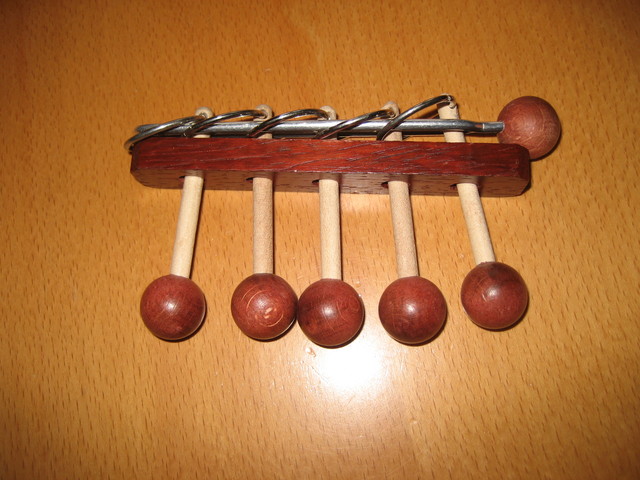
There are some puzzles that have been there for a long time and have their roots that far back in the past that their origin is not known exactly. The traditional six piece burrs are one such example, the Chinese Rings puzzle another. For some information about the history of the Chinese Rings (also known as "Nine Linked Rings") see [9].

In this compendium, we exhibit a collection of all puzzles known to us that are all related to this type of puzzles, why we will call them "Chinese-Rings-like puzzles", or more formally, "CR recursive puzzles". A common similarity for all these puzzles is that they have an astonishing high number of moves to solve and they have several rings or pieces working in a similar way in the solution.
Our Compendium features a large variety of different puzzles: Disentanglement puzzles, sliding pieces puzzles, puzzle boxes, burrs, sequential movement puzzles, ball maze puzzles, and even puzzle games with certain rules.
|
SpinOut |
Crazy Elephants Dance |
Kugellager |
The last example above, the "Kugellager", is the puzzle that started our research and lead to the first article about this puzzle and similar puzzles: [1]. In that article, the "Kugellager" puzzle with its 1250 moves is analyzed and later on short analyses of other puzzles like "Die Welle" were added and a table was created showing several puzzles that are now in this compendium. After collecting some of the related puzzles, a group page was set up and the term "n-ary puzzle" was termed for these puzzles: [2]. This term n-ary was also used in a nice article [11] about designing n-ary puzzles which appeared in CFF 15 in November 2014. The most recent exteded version of this article can be found in [12].
The list of puzzles is the main part of this compendium. It lists the puzzles with several details in entries ordered alphabetically by their names.
| Puzzle-ID | Name | (example entry for explanation of fields) | |||
|---|---|---|---|---|---|
| Image(s) of puzzle. Click on image or links for bigger image versions. |
Designer | Manufacturer | Year | ||
| Name of creator of puzzle design | Name/Company name of manufacturer | Year of first release | |||
| Arity | No of pieces | Piece type | Solution length function | Number of moves | |
| # of Levels (n) or n' [n], see note below | special pieces only | of special pieces (m) | exact or asymptotic (Θ) function of n and m | counted/calculated | |
| Remarks | Remarks about special features, similar puzzles. | ||||
| References | Links to patents, Extremely Puzzling page, other web pages on this puzzle | ||||
| Symbols: | §=counting moves of special pieces only; ‡=counting moves until first piece comes out | ||||
Note on the Arity: While n (and hence the arity) by Definition 3.1 in this compendium is the number of different positions each piece can have (including possibly the "removed" state if it occurs regularly during the n-ary sequence, not only at the end when all pieces are removed at once), there are puzzles, for which a generally accepted arity has been defined by the designer of the puzzle, and which is usually aligned to the solution length, and the base of the exponential function describing the solution lengths. In this cases, a bracket notation is used in the arity field for the defined arity n' and the number of levels n:
n' [ n ]
For example, the Racktangle puzzle would have defined arity 3, yet the pieces have 5 different positions (two additional positions to ensure the solution length proportional to 3m), and this would be denoted by: "3 [5]".
If there are single pieces with different number of positions (e.g. when only one piece comes out of the puzzle in the n-ary sequence), then only the number of positions/levels for the majority is provided.
Hint: Even if the list cannot be ordered for other fields, you can easily search for a certain entry using your web browser's built in search function (usually invoked by keys Ctrl-F or F3).
Hint: For previews of secondary images or the variants (entries with IDs), please hover the mouse pointer over the corresponding link (without clicking). In the top right corner of the browser window, a preview will appear. Unfortunately, this does not work on all browsers; in particular some Internet Explorer versions do not show these previews.
Beside this introduction and the list of puzzles there are also a page with a formal definition of the structure of puzzles that belong into this compendium, including some properties and examples. The compendium is concluded by a page to contribute to this compendium by adding puzzles or new information. Please have a look at the navigation bar on top of all pages or the table of contents below.
There is a also a one-page print view containing everything on one huge page and that can nicely be printed onto paper or e.g. into a PDF file to take an offline copy of the compendium with you. It does not contain page numbers, as these would vary depending on the format you choose to print. To view, please click on this link.